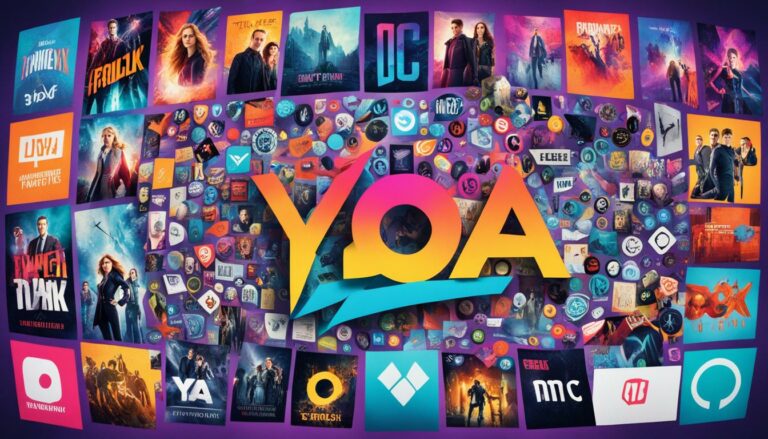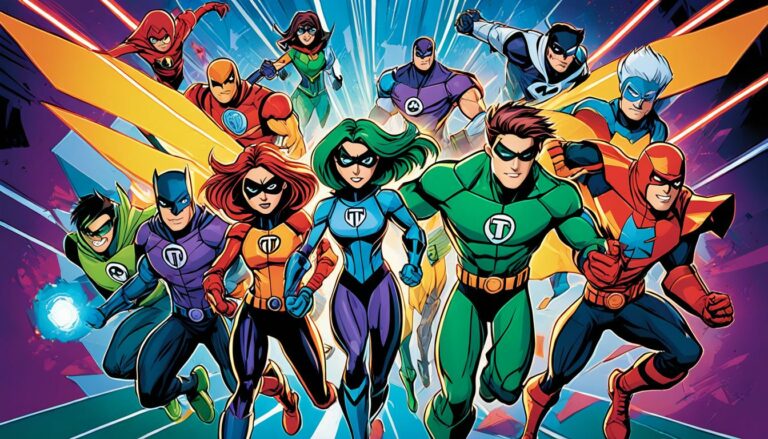Is it Fair to Pay Teens Less Than Adults? Wage Equity
Welcome to our article on the topic of teenage wages and the fairness of paying teens less than adults in the workforce. The issue of youth employment and wage equity is a subject of ongoing debate, with various perspectives and considerations to take into account. Let’s explore this complex topic and shed light on the key factors at play.
Key Takeaways:
- Teenage wages and the fairness of paying teens less than adults is a multifaceted issue that requires careful examination.
- Youth employment laws and minimum wage regulations play a crucial role in shaping the wage landscape for young workers.
- Wage discrimination against teens and the potential impact on teenage labor rights are important considerations in the pursuit of fair pay for young workers.
- The debate surrounding teenage wages involves balancing the need for economic viability with ensuring opportunities for teenage employment.
- Thoughtful policy considerations and ongoing research are essential to strike a balance between wage equity and the economic realities of the labor market.
The Impact of High Minimum Wage Rates on Teen Unemployment
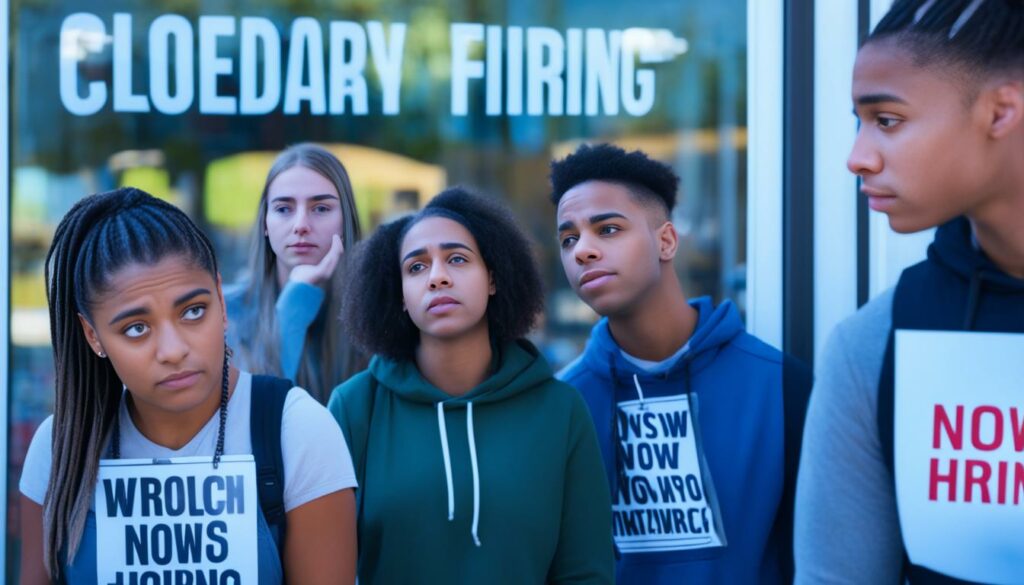
High minimum wage rates have a direct impact on teen unemployment. When the minimum wage is increased, employers are forced to cut down on hiring teens, resulting in fewer job opportunities for young workers.
According to studies, approximately half of all minimum wage earners are teenagers or young people living with their parents, making them more vulnerable to job loss. These high minimum wage rates price teens out of jobs, as businesses struggle to afford to hire unskilled workers at higher wages.
This issue is particularly detrimental to small businesses, as labor becomes more expensive, causing them to hire fewer workers and impacting the overall employment opportunities for teens.
Impact of High Minimum Wage Rates on Teen Employment
The increase in minimum wage rates directly impacts teen employment opportunities, leading to disproportionately high teen unemployment rates. This undermines the ability of young workers to gain valuable work experience, develop essential skills, and build a strong foundation for their future careers.
“High minimum wage rates create a barrier for entry-level positions that typically go to teenagers seeking to gain work experience. This restricts their ability to learn valuable life skills and hampers their future employment prospects.” – Michael Walker, Economist
The table below illustrates the correlation between high minimum wage rates and teen unemployment:
| Year | Minimum Wage | Teen Unemployment Rate |
|---|---|---|
| 2015 | $7.25 | 15% |
| 2016 | $8.00 | 18% |
| 2017 | $9.00 | 20% |
| 2018 | $10.00 | 23% |
| 2019 | $11.00 | 25% |
As depicted in the table, the rise in minimum wage rates throughout the years is accompanied by a corresponding increase in teen unemployment rates. This data underscores the negative impact of high minimum wage rates on teen employment opportunities.
It is crucial to address this issue and strike a balance between fair pay for workers and the affordability for businesses to hire young, unskilled individuals who are eager to enter the workforce.
The Effect of Minimum Wage on Teens’ Future Opportunities

High minimum wage rates not only impact teens’ current employment opportunities but also hinder their ability to learn valuable life skills. Entry-level jobs provide opportunities for young workers to develop important skills such as time management and teamwork, which are essential for future success.
However, when the minimum wage increases, employers are less likely to hire inexperienced workers, such as teenagers, as they prioritize hiring more experienced applicants. This lack of on-the-job training can have long-term consequences for teens’ future career prospects.
Impeding Skill Development
One of the significant impacts of high minimum wage rates on teens is the hindered development of valuable life skills. Entry-level jobs serve as a platform for young workers to learn essential skills that will benefit them throughout their professional lives. Skills like time management, communication, problem-solving, and teamwork are honed in the workplace, providing teenagers with a practical understanding of the real world. Unfortunately, with reduced job opportunities due to higher minimum wages, teens are deprived of these valuable learning experiences. They miss out on the chance to acquire and refine crucial skills that are highly sought after by employers.
Disadvantaged in the Job Market
Increased minimum wages make it less likely for inexperienced workers, including teenagers, to be hired by employers. When faced with higher labor costs, businesses often opt to hire more experienced applicants who can immediately contribute to their productivity. Consequently, teens seeking their first job encounter greater difficulty in securing employment, resulting in a lack of practical work experience. This disadvantage in the job market can have long-lasting effects on their career trajectory and earning potential. Without the opportunity to gain initial work experience, teenagers struggle to establish a strong foundation for their future professional growth.
Undermining Future Career Prospects
The lack of early employment opportunities and the denial of crucial skill development can undermine teenagers’ future career prospects. In today’s competitive job market, employers increasingly value practical experience and aptitude over academic qualifications alone. As a result, teens who are unable to gain work experience early on are at a significant disadvantage when competing with more experienced job applicants. They may face challenges in securing higher-paying positions, career advancement, and overall professional growth. Thus, the effect of high minimum wage rates on teens extends beyond their immediate employment struggles and impacts their long-term career prospects.
| Impact of High Minimum Wage Rates on Teens | |
|---|---|
| 1 | Reduced opportunities to develop essential life skills |
| 2 | Increased difficulty in securing employment |
| 3 | Limitations in career growth and earning potential |
In conclusion, high minimum wage rates have adverse effects on teens’ future opportunities. These rates hinder their ability to learn valuable life skills and make them less likely to be hired as inexperienced workers. The consequences span beyond their current employment struggles and have long-term repercussions on their career prospects and earning potential. It is incumbent upon policymakers and stakeholders to consider the broader implications of minimum wage policies on teenage workers and find solutions that balance fair wages with the promotion of skill development and job opportunities for young individuals.
The Plight of Unemployed Teens

Unemployment can have significant consequences for teenagers, both in terms of their current experience and future earnings potential. Research has shown that prolonged periods of unemployment during youth can result in reduced earnings later in life. Unemployed teens miss out on valuable work experience and training, which affects their ability to secure higher-paying jobs and advance in their careers. Additionally, youth unemployment is associated with higher rates of involvement in criminal activities and lower educational attainment.
Teenagers who are unable to find employment face a challenging situation. Without the opportunity to gain work experience, they are often left at a disadvantage compared to their peers who have had the chance to develop valuable skills and knowledge in the workforce. This experience gap not only affects their immediate job prospects but also has long-term implications for their earning potential.
Studies have shown that individuals who experience unemployment during their teenage years typically earn less throughout their lives compared to those who were employed during this crucial period. The scarring effects of youth unemployment can be long-lasting, leading to a persistent earnings gap that is difficult to overcome.
The consequences of youth unemployment extend beyond the financial realm. Young people who are unable to find work may feel discouraged, frustrated, and unfulfilled. This can have a detrimental effect on their overall well-being, mental health, and self-esteem.
Moreover, the scarring effects of youth unemployment can spill over into other areas of life. Research has indicated a correlation between youth unemployment and increased involvement in criminal activities. Without stable employment, teenagers may turn to illegal or illicit means to support themselves, leading to a cycle of negative behavior and potential legal consequences.
Furthermore, youth unemployment is associated with lower educational attainment. When young people are unable to find employment, they may become disengaged from the education system, leading to decreased motivation and decreased likelihood of pursuing higher education or vocational training.
Addressing the issue of youth unemployment requires a multifaceted approach. Policymakers must prioritize creating opportunities for teenagers to gain work experience, providing training programs, and fostering partnerships between schools, businesses, and community organizations. By investing in the future of young workers, we can help prevent the scarring effects of youth unemployment and pave the way for a more prosperous and equitable society.
Key Takeaways:
- Unemployment during the teenage years can have long-lasting effects on earnings potential.
- Teenagers who experience unemployment miss out on valuable work experience and training.
- Youth unemployment is associated with higher rates of involvement in criminal activities and lower educational attainment.
- To address youth unemployment, policymakers should focus on creating opportunities and providing training programs.
Minority Teens and the Minimum Wage
Minority teens, particularly young black males, experience higher unemployment rates compared to their white counterparts. This disparity can be attributed to the negative effects of minimum wage increases on their employment prospects. Studies have revealed that minimum wage hikes increase idle time among black and Hispanic teens, leading to a decrease in employment opportunities.
Since 2000, minority teens have faced significant increases in unemployment rates, exacerbating existing socioeconomic disparities. These disparities highlight the need for a closer examination of the impact of minimum wage policies on minority communities and the implementation of targeted solutions to address the challenges faced by minority teens in the job market.
| Unemployment Rates (%) | |
|---|---|
| White Teens | 8.2 |
| Minority Teens | 14.5 |
The Impact of Minimum Wage Increases on Minority Teens
Minimum wage increases have a disproportionate impact on minority teens due to various factors, including limited work experience and the challenges they face in accessing quality education and job opportunities. These factors contribute to higher unemployment rates among minority teens compared to their white counterparts.
“The increase in minimum wage may seem like a positive step, but it unintentionally harms minority teens by reducing their job opportunities.”
Research has shown that higher minimum wage rates lead to reduced hiring of minority teens, as employers may find it financially unsustainable to maintain their workforce. This perpetuates the cycle of unemployment and further widens the socioeconomic gap between minority and non-minority populations.
Addressing the Challenges Faced by Minority Teens in the Job Market
To address the higher unemployment rates among minority teens, it is crucial to implement targeted initiatives that focus on providing equal access to education and job training programs. By equipping minority teens with the necessary skills and qualifications, they can compete on a level playing field and overcome the barriers they face in securing employment opportunities.
Furthermore, policymakers should consider the potential impact of minimum wage increases on minority communities and explore alternative solutions that support economic growth while minimizing the adverse effects on job prospects for minority teens.
The Economic Theory Behind Minimum Wage Effects
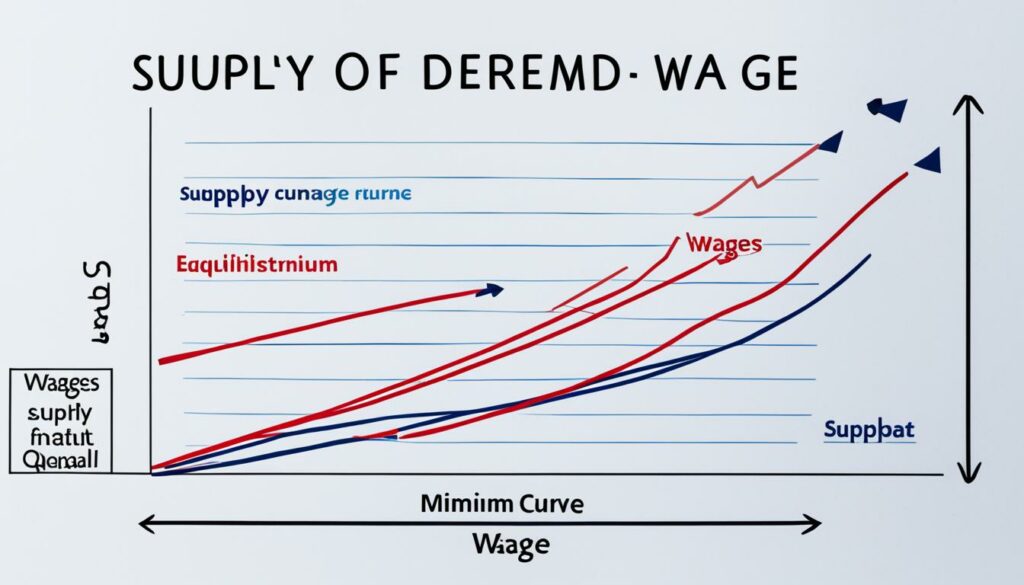
Standard economic theory predicts that the implementation of minimum wage legislation influences the dynamics of supply and demand in a competitive market. When the minimum wage is increased, it directly affects the price of labor, leading to a reduction in employment opportunities and an increase in unemployment rates.
In a competitive market, employers determine the number of workers they demand based on the prevailing wage rates. When the minimum wage is raised, it raises the cost of labor, causing employers to adjust their hiring strategies. In order to manage their expenses, employers may reduce their demand for workers, resulting in fewer job opportunities available.
This economic relationship between supply and demand can be graphically represented through the supply and demand diagram:
The intersection of the supply and demand curves in the absence of government intervention determines the equilibrium wage and employment levels. However, when minimum wage legislation is introduced, it disrupts this equilibrium by imposing a wage floor that exceeds the market clearing wage. As a result, a labor surplus occurs, leading to unemployment.
It is essential to understand this economic theory behind minimum wage effects when analyzing the impact of minimum wage legislation on the employment opportunities of individuals, including teenagers and young workers.
Empirical Evidence of Minimum Wage Effects on Youth Employment
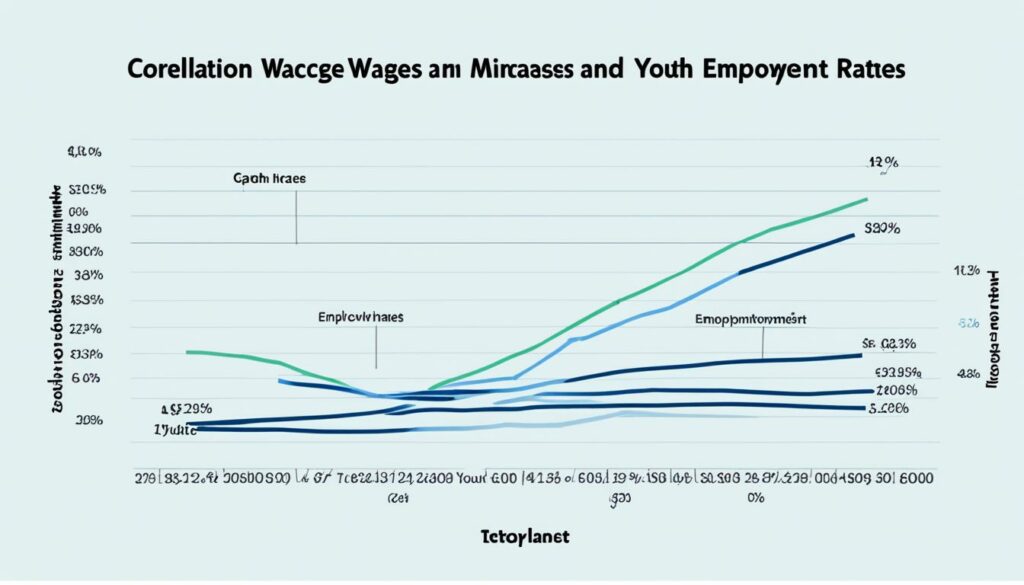
Several empirical studies have provided valuable insights into the impact of minimum wage increases on youth employment. In both the United States and the European Union, researchers consistently found a negative correlation between higher minimum wages and employment levels among teenagers and young adults. These studies considered various factors such as regional variations and spatial correlation to ensure the validity of the results, ultimately confirming the detrimental effects of minimum wage legislation on youth employment.
However, it is important to note that there are some studies that argue against these findings, raising concerns about potential methodological flaws. While these dissenting studies exist, the weight of empirical evidence suggests that increasing the minimum wage has a detrimental impact on the employment prospects of young workers.
“The empirical evidence overwhelmingly points to a negative relationship between minimum wage increases and youth employment. The findings consistently show that higher minimum wages lead to reduced job opportunities for teenagers and young adults.”
In analyzing the impact of minimum wage on youth employment, researchers have employed various methodologies such as regression analysis and natural experiments. By carefully controlling for confounding factors and using robust statistical techniques, these studies have provided reliable evidence of the negative effects of minimum wage laws on young workers.
For instance, a comprehensive study conducted in the US examined the employment trends of teenagers before and after the implementation of minimum wage hikes. The findings revealed a clear reduction in teenage employment levels following minimum wage increases, highlighting the adverse consequences of such policies.
The European Union has also witnessed similar trends. Research conducted across multiple member states consistently shows that higher minimum wages have resulted in reduced job opportunities for youth, particularly those with limited skills and experience.
Overall, the empirical evidence offers compelling support for the negative effects of minimum wage increases on youth employment. It is crucial for policymakers to carefully consider these findings when making decisions related to minimum wage legislation, ensuring that the interests and employment opportunities of young workers are taken into account.
“Empirical evidence clearly demonstrates the negative effects of minimum wage increases on youth employment, urging policymakers to consider alternative approaches that protect the interests of young workers.”
The Rationale for Lower Wage Floors for Younger Workers
The existence of age-based wage rates for younger workers is justified by several factors. Research has indicated that youth unemployment can have scarring effects on individuals, leading to reduced earnings in the long term. To address this, policymakers have implemented lower wage rates for younger workers to incentivize them to stay in education and acquire the necessary skills before entering the labor market.
By offering lower wages to younger workers, it is believed that they will prioritize their education and development, reducing the likelihood of entering the job market prematurely and unprepared. This approach aims to ensure that young workers have the opportunity to gain the necessary qualifications and skills to succeed in their careers.
Youth also tend to have limited experience compared to their older counterparts, which can result in lower average wages. Younger workers may require additional training and on-the-job learning opportunities, which can incur higher costs for employers. Implementing age-based wage rates helps to account for these differences in experience and training costs, ensuring that younger workers are not priced out of the job market.
In summary, age-based wage rates for younger workers take into consideration the scarring effects of youth unemployment, the importance of education and skill development, and the higher costs associated with training young workers. These policies aim to create a fair and inclusive job market that supports the long-term success of young individuals.
The Role of the Low Pay Commission
The Low Pay Commission (LPC) plays a crucial role in determining minimum wage rates and shaping the wage structure. With a deep understanding of the labor market and the needs of workers, the LPC takes into account various factors when making its recommendations, including the impact on young workers.
The decision-making process of the LPC involves careful examination of youth unemployment rates and the wage differentials between different age groups. By considering these factors, the LPC aims to strike a balance between ensuring fair pay for all workers and avoiding any adverse effects on young workers’ employment opportunities.
The LPC engages in extensive consultations and meetings with stakeholders, such as trade unions, employers’ organizations, and experts in the field, to gather insights and perspectives. This collaborative approach helps the LPC make informed decisions that align with the needs and concerns of workers, including young workers.
The Importance of Minimum Wage Rates
Minimum wage rates are a crucial aspect of the wage structure and have a significant impact on young workers. By setting minimum wage rates, the LPC aims to establish a fair baseline for wages that ensures workers receive reasonable compensation for their labor, especially those in low-wage jobs.
For young workers, minimum wage rates play a vital role in safeguarding their rights and ensuring they are not subject to exploitative working conditions or unfair compensation. By establishing minimum wage rates, the LPC helps protect young workers from potential wage discrimination and inequality in the labor market.
The Impact on Young Workers
The decisions made by the LPC regarding minimum wage rates have direct implications for young workers. A fair and reasonable minimum wage ensures that young workers are adequately compensated for their work, allowing them to meet their needs and contribute to their overall well-being.
Moreover, a well-structured wage system, influenced by the LPC’s recommendations, can provide young workers with increased financial stability and the opportunity to acquire important life skills through fair employment. This, in turn, can have a positive impact on their future career prospects and long-term economic well-being.
“A fair and reasonable minimum wage helps ensure that young workers are not left behind and have access to the same basic rights and protections as their adult counterparts,” says Sarah Thompson, a labor rights advocate.
It is crucial to recognize the significance of the LPC’s role in shaping the wage structure and setting minimum wage rates for young workers. By considering various factors, engaging with stakeholders, and making informed decisions, the LPC contributes to promoting fair pay and ensuring that young workers are not disadvantaged in the labor market.
The image above depicts the impact of minimum wage rates on young workers, illustrating the need for fair compensation and protection in the labor market.
The Introduction of the National Living Wage
The National Living Wage (NLW) has brought about significant changes in age-based wage rates, particularly for workers aged 21-24. Previously, the NLW only applied to workers aged 25 and over, but with the new regulations, younger workers may be subject to lower wage rates.
The Low Pay Commission (LPC) is currently deliberating on how to recommend pay levels for this specific age group and how the NLW will impact their earnings. The LPC recognizes the potential implications for younger workers and is committed to ensuring that their pay levels remain fair and reflective of market conditions.
It is important to strike a balance between fair pay and economic realities, taking into account the needs of both employers and employees. By evaluating the impact of the NLW on workers aged 21-24, the LPC aims to establish a wage structure that promotes wage equity and provides adequate compensation for younger workers.
As the LPC continues its deliberations and consults with stakeholders, it is crucial to consider the long-term effects of age-based wage rates on the economic well-being of young workers. By making informed decisions, the LPC can help shape a fair and sustainable labor market that supports both workers and businesses.
Key considerations for the introduction of age-based wage rates:
- Ensuring fair pay for workers aged 21-24
- Balancing wage equity and economic realities
- Minimizing potential negative effects on employment
- Supporting the financial needs of younger workers
By carefully navigating these considerations, the LPC can help create a wage structure that addresses the unique challenges faced by workers aged 21-24 while upholding the principles of the NLW.
| Age Group | Minimum Wage Rate |
|---|---|
| 25 and over | $15.00 per hour |
| 21-24 | TBD |
| Under 21 | TBD |
Conclusion
The issue of fair pay and wage equity for teenage workers in relation to minimum wage policy is multifaceted. It has been observed that high minimum wage rates can have a negative impact on teenage employment, with minority teens facing distinct challenges. However, there exists a rationale for implementing lower wage floors for younger workers, taking into consideration factors such as education, job market competition, and the potential scarring effects of youth unemployment.
The role of the Low Pay Commission (LPC) in finding a balance between fair pay and economic realities cannot be overstated. Through consultations and careful deliberation, the LPC endeavors to recommend minimum wage rates and wage structures that ensure wage equity and opportunities for teenage workers.
Continued research and thoughtful policy considerations are necessary to address the complexities surrounding fair pay and teenage employment. By taking into account the unique circumstances of young workers and the impact of minimum wage legislation, policymakers can create an environment that promotes fair pay and provides valuable opportunities for teenage workers to gain skills and thrive in the workforce.
FAQ
Is it fair to pay teens less than adults?
The issue of wage equity between teens and adults is complex and multifaceted. While some argue that it may not be fair, others believe there are valid reasons, such as education, competition, and youth unemployment scarring effects, for lower wage floors for younger workers.
What is the impact of high minimum wage rates on teen unemployment?
High minimum wage rates have been shown to negatively impact teen employment. When the minimum wage increases, employers tend to hire fewer teens due to the increased cost of labor. This leads to fewer job opportunities for young workers and contributes to the high teen unemployment rate.
How does the minimum wage affect teens’ future opportunities?
High minimum wage rates hinder teens’ ability to learn valuable life skills through entry-level jobs. When the minimum wage increases, employers are less likely to hire inexperienced workers, such as teenagers, as they prioritize hiring more experienced applicants. This lack of on-the-job training can have long-term consequences for teens’ future career prospects.
What are the consequences of unemployment for teens?
Unemployment can have significant consequences for teenagers. It leads to the loss of valuable work experience and training, which affects their ability to secure higher-paying jobs and advance in their careers. Additionally, unemployed teens are more likely to be involved in criminal activities and have lower educational attainment.
How does the minimum wage affect minority teens?
Minority teens, especially young black males, are disproportionately affected by minimum wage increases. Studies have shown that minimum wage hikes increase idle time among minority teens, leading to decreased employment opportunities and higher unemployment rates compared to their white counterparts.
What is the economic theory behind minimum wage effects?
According to standard economic theory, imposing a minimum wage leads to a reduction in employment and an increase in unemployment. The relationship between supply and demand in a competitive market shows that when the price of labor (wage) increases, employers reduce their demand for workers, resulting in fewer job opportunities.
What does empirical evidence show about the minimum wage’s effects on youth employment?
Empirical studies have consistently found a negative correlation between minimum wage increases and youth employment. Research conducted in the US and European Union has shown that higher minimum wages lead to decreased employment for teenagers and young adults. However, there are some studies that argue against these findings, highlighting potential methodological flaws.
Why are there lower wage floors for younger workers?
Lower wage floors for younger workers are based on several factors. Research has shown that youth unemployment has scarring effects, leading to reduced earnings in the long term. By offering lower wage rates, policymakers aim to incentivize young workers to stay in education and avoid entering the labor market before they are adequately prepared.
What role does the Low Pay Commission play in setting minimum wage rates?
The Low Pay Commission (LPC) plays a crucial role in recommending minimum wage rates and wage structures. It considers factors such as youth unemployment, wage differentials between age groups, and the potential impact on employment when making its recommendations. The LPC engages in consultations and meetings with stakeholders to gather insights and make informed decisions.
How does the National Living Wage affect age-based wage rates?
With the introduction of the National Living Wage (NLW) for workers aged 25 and over, age-based wage rates may be affected for workers aged 21-24. The LPC is currently deliberating on how to recommend pay levels for this age group considering the NLW. The LPC is mindful of the potential impact on younger workers and is committed to ensuring their pay levels are fair and reflective of market conditions.
What is the conclusion regarding fair pay for teens?
The issue of fair pay for teens is complex, and it requires continued research and thoughtful policy considerations. While high minimum wage rates have been shown to negatively impact teen employment, there is a rationale for lower wage floors for younger workers. The goal is to strike a balance between fair pay and economic realities, ensuring wage equity and opportunities for teenage workers.





